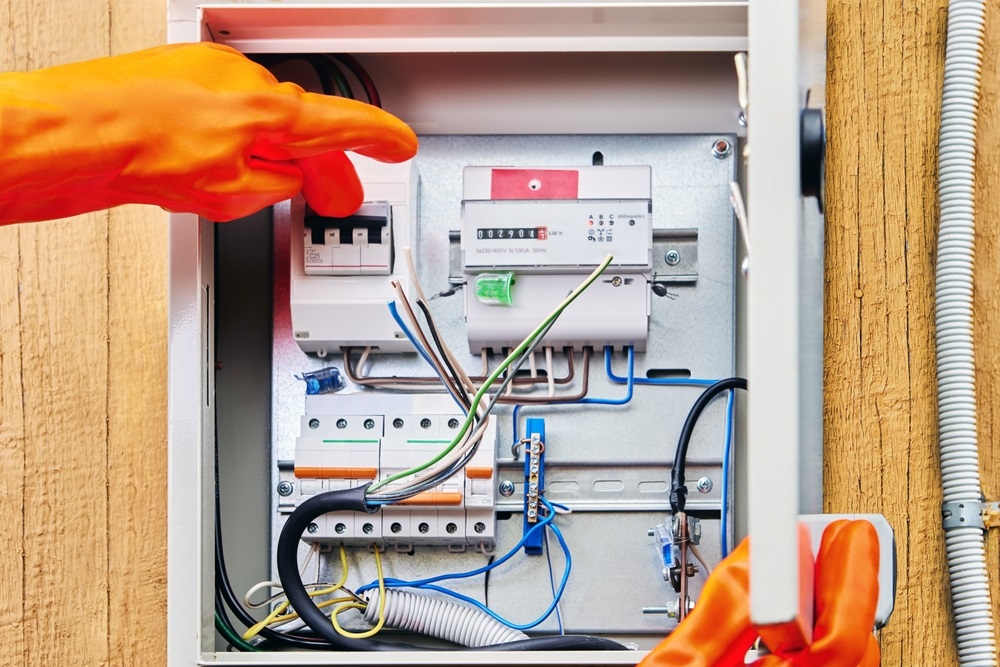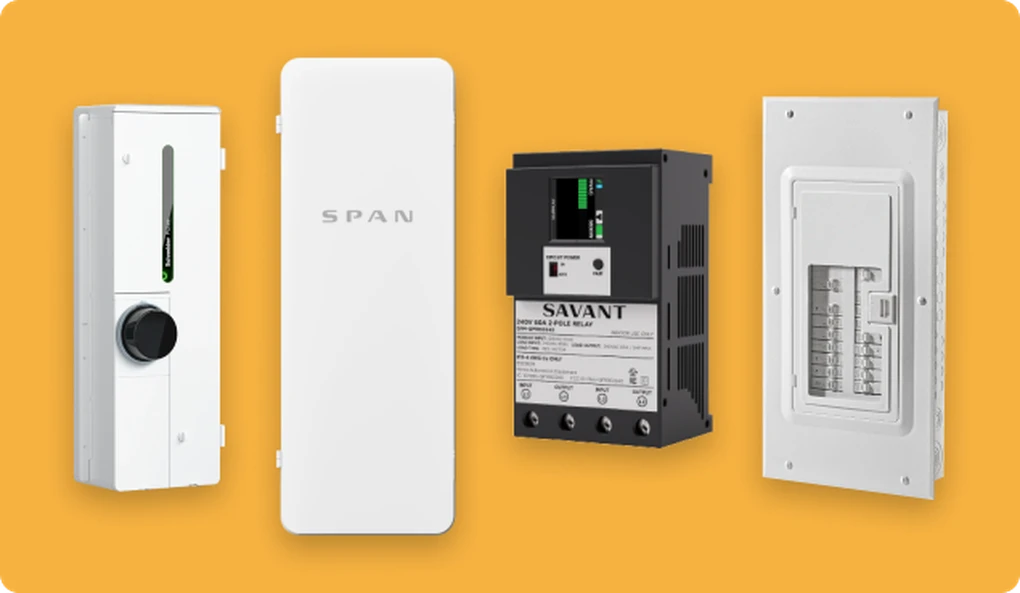As homes become more digitized and energy-efficient, the old breaker box just doesn’t cut it anymore. Whether you’re planning a gut renovation, adding a heat pump, or integrating smart home gadgets, the right choice for your home’s power system often begins with upgrading the electrical panel.
A smart electrical panel for home acts not just as a power distributor, but as an energy management system, integrating your home into the future of home electrification. So how do smart electric panels stack up against traditional ones? Is it worth replacing your old breaker box with a new electrical panel? Let’s explore the key differences, benefits, and practical considerations to help you make an informed decision.
Understanding the Basics of Electrical Panels
The Role of Electrical Panels in Homes
Every home relies on its electrical panel to deliver power safely to all appliances and circuits. It receives grid power from your utility’s service line and distributes it across your home. From your entertainment center to large appliances like washing machines or ovens, the panel ensures everything gets the right amount of energy without overloading.
As we increasingly adopt electric appliances, the need for a service upgrade becomes inevitable. Whether it’s to support a backup power system, an EV charger, or a clean energy upgrade, your electrical panel must evolve with your needs.

Traditional Electrical Panels
Traditional panels—also known as breaker boxes—have been the standard for decades. They perform well in basic scenarios but lack the intelligence to manage today’s complex energy ecosystems.
Limitations:
- No ability to monitor energy consumption in real time.
- Manual resets during a power outage.
- No integration with smart home gadgets or renewable systems.
While still functional, they offer little support for home electrification or efficient energy management.
Read More: What Are the Electrical Panel Labeling Standards?
Smart Electrical Panels
A smart electrical panel is a transformative upgrade that brings connectivity, control, and automation to your electrical system. Brands like the Span panel are redefining what a panel can do by turning it into a digital dashboard for your home’s electricity.
Smart electric panels enable:
- Real-time energy monitor functionality.
- Remote control and diagnostics.
- Prioritized circuits during backup power scenarios.
- Integration with government agencies’ rebate programs for clean energy upgrades.
What Are the Main Benefits of Smart Panels?
A smart electrical panel isn’t just a fancy gadget—it’s a practical investment that enhances safety, control, and future readiness. Here’s why:
- Energy Monitoring: See how much power each circuit uses, identify inefficiencies, and adjust in real time.
- Remote Access: Manage your system through an app, whether you’re upstairs or across the globe.
- Home Safety: Get alerts before overloaded circuits become dangerous, helping prevent fires and electrical faults.
- Backup Power Management: In a power outage, automatically prioritize essential loads like your heat pump or refrigerator.
- Smart Integration: Seamlessly connects with smart home gadgets, solar panels, and battery systems.
- Support for Electrification: Ideal for modern homes with a lot of power needs, such as EVs, large appliances, and electric HVAC systems.
- Grid Interaction: Helps manage grid power usage, reducing peak-time consumption and saving money.
How Do Smart Panels Work?
Smart panels combine the safety functions of traditional panels with software-based intelligence. At the hardware level, they still route electricity from your electrical service to individual circuits. But unlike their analog ancestors, these panels include sensors and a rating system that tracks your energy consumption per circuit.
They connect to your home’s Wi-Fi, allowing you to view and control your usage via mobile apps. During a power outage, smart panels can activate backup power systems, selectively powering primary sources like your entertainment center or home office while keeping non-essentials offline.
If you’re working with a dispute resolution service to resolve energy billing issues, the data from your smart panel can serve as proof of actual consumption patterns.

Smart Electrical Panels vs Traditional Panels: Pros and Cons
Functionality and Monitoring
Traditional panels are reactive; they only alert you after a problem occurs. In contrast, smart electrical panels are proactive and interactive. You get alerts about overloads, faulty circuits, or devices drawing too much energy—often before something goes wrong.
Energy Efficiency
Smart panels help reduce unnecessary power usage, commonly referred to as “phantom loads.” They allow homeowners to detect which appliances are using electricity even when turned off.
For example, by scheduling when your EV charges or turning off idle appliances, you can significantly cut down energy bills. In this way, smart electrical panel residential systems support better energy stewardship.
Integration with Renewables
Traditional panels typically don’t manage power flow from solar panels or battery storage systems. But a smart electrical panel 200 amp model often comes preconfigured to:
- Balance input from the grid and solar.
- Manage battery charging/discharging.
- Prioritize essential circuits during an outage.
This integration is crucial for anyone using—or planning to use—renewable energy sources.
Safety
Smart panels go beyond the basic breaker trip. They often include advanced sensors that detect arc faults, ground faults, and overheating wires. You’ll receive real-time alerts before something turns into a fire hazard.
| Feature | Traditional Electrical Panels | Smart Electrical Panels |
| Energy Monitoring | ❌ None | ✅ Real-time tracking with an energy monitor |
| Remote Control | ❌ Manual reset required | ✅ Mobile app control |
| Grid Interaction | ❌ Limited | ✅ Manages grid power and peak-time usage |
| Smart Home Compatibility | ❌ None | ✅ Integrates with smart home gadgets |
| Backup Power | ❌ Manual generator switch required | ✅ Auto management during power outage |
| Service Upgrade Ready | ❌ Often requires a full electrical service upgrade | ✅ Built for service upgrade flexibility |
| Installation Cost | ✅ Lower upfront | ❌ Higher ($2,000–$5,000), but rebates available |
| Maintenance | ✅ Minimal | ✅ Software updates needed occasionally |
| Home Electrification Support | ❌ Inadequate | ✅ Designed for EVs, heat pumps, etc. |
| User Experience | ❌ Passive | ✅ Dynamic, data-driven |
Why You Might Need a Smart Panel
Future-Proofing Your Home
If you’re adding electric appliances like an EV charger or heat pump, your old panel may not deliver enough power. A 200 amp smart electrical panel supports high loads and complex circuits, ensuring your home remains compliant and efficient.
Clean Energy Upgrades
Looking to take advantage of government agencies’ incentives? Many smart electrical panels qualify for rebates as part of clean energy upgrades—especially when paired with solar or battery storage.
Energy Usage Transparency
Whether you’re a tech enthusiast or just want to keep bills down, smart panels help you understand where your energy is going. If you’re ever in dispute with your service providers about charges, panel-generated data can support your case through a dispute resolution service.
What to Know Before Installing
Smart Electrical Panel Price
The smart electrical panel cost ranges from $2,000 to $5,000, depending on amperage (100 or 200 amp), features, and your home’s layout. If your home needs a service upgrade to handle the panel, costs can go higher.
Smart Electrical Panel Installation
Installation is not DIY-friendly. You’ll need a licensed contractor for a safe, code-compliant install—especially if your system requires an electrical service upgrade.
Types of Electrical Panels to Consider
Here are the common electrical panels types found in residential settings:
- Main Breaker Panels – Controls power across the home.
- Subpanels – Great for additions or detached garages.
- Transfer Switch Panels – Used for generator tie-ins.
- Smart Panels (e.g., Span Panel) – Best for modern energy management systems.
Are Smart Panels Reliable?
Yes, smart electrical panels are highly reliable and are designed with durability, safety, and precision in mind. Most residential smart electrical panel systems come from trusted manufacturers like Span, Leviton, and Schneider Electric—brands with longstanding reputations in the electrical and energy management industry. These panels are built to handle everything from high electrical loads to integration with solar and battery systems, ensuring performance even under demanding conditions.
Beyond hardware reliability, smart panels offer advanced software features that enhance dependability. Real-time diagnostics, remote troubleshooting capabilities, and firmware updates mean your smart electrical panel for home can stay updated and adapt to new technologies over time. And since most smart panels come with built-in redundancies and alerts for anomalies like arc faults or overheating, they often catch issues well before they become critical—adding a level of reliability traditional panels simply can’t match.
Read More: Electrical Panels: When to Fix and When to Replace Your Panel
Frequently Asked Questions (FAQs)
WHAT IS THE AVERAGE SMART ELECTRICAL PANEL COST?
Between $2,000 and $5,000. Costs may vary based on panel size, brand, and whether a service upgrade is needed.
CAN I INSTALL A SMART PANEL MYSELF?
No. Always work with certified service providers for installation and inspection, especially if you’re upgrading your electrical service.
IS A 200 AMP SMART ELECTRICAL PANEL NECESSARY?
If your home uses a lot of power—such as EV charging, electric HVAC, or clean energy upgrades—then yes, a 200-amp panel is strongly recommended.
HOW DO SMART PANELS HANDLE POWER OUTAGES?
Smart panels support backup power by prioritizing primary sources, keeping essential systems online while conserving stored energy.
DO SMART PANELS HELP WITH ENERGY BILLING DISPUTES?
Yes. Their energy monitor capabilities generate detailed usage reports, helpful when using a dispute resolution service with your utility.
Conclusion
Whether you’re navigating home electrification, preparing for clean energy upgrades, or just want more control over your energy consumption, a smart electrical panel is a strategic investment. It offers safety, control, and efficiency that traditional panels simply can’t match.
From managing backup power during outages to supporting heavy electric appliance loads, smart panels like the Span panel are helping homes transition to a cleaner, smarter energy future. For a seamless smart electrical panel installation and expert advice on service upgrades, contact Pelican Coast Electric—your trusted partner in powering the modern home.


